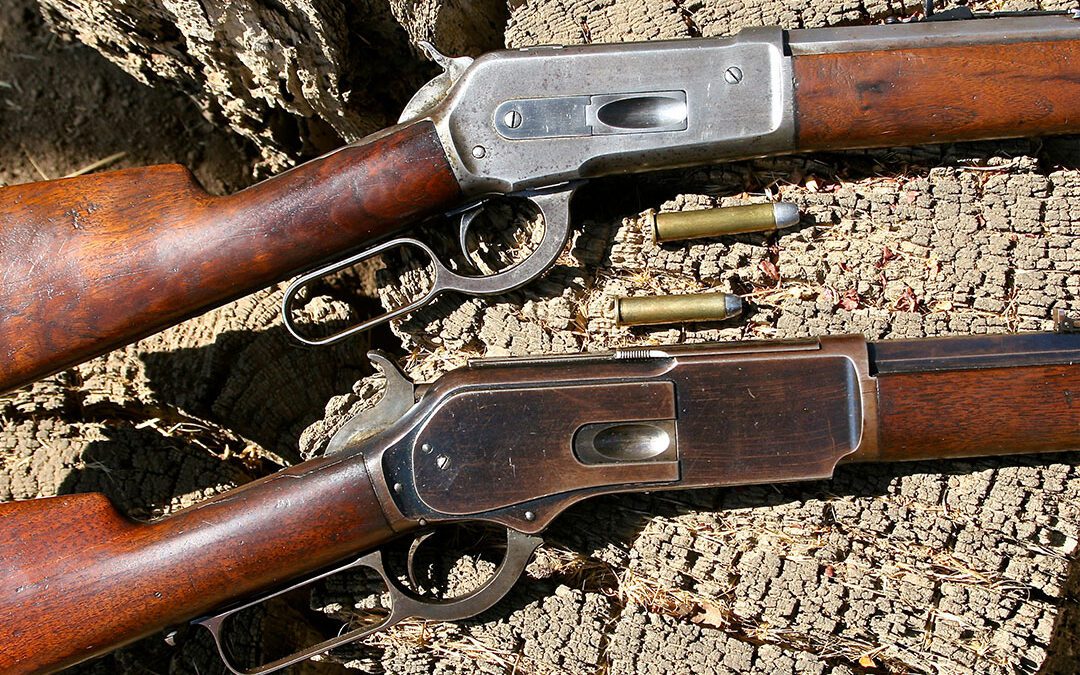There was a time, say about 125 years ago, when lever-action rifles ruled the shooting scene, whether it was in a saddle scabbard, a hunting camp or simply leaning against a homesteader’s corner wall. These hand-cranked shooting sticks ran the gamut from weather-beaten dinged up working tools to elegantly engraved and furniture-grade stocked works of art and were effectively used by everyone from dollar-a-day drovers to celebrities and other notable personages of their day. To be sure, the lever action was “everyman’s” rifle.
Their story—and their history—began in 1860, when Benjamin Tyler Henry finally perfected a lever-action repeating rifle that Oliver Winchester had acquired with his purchase of the Volcanic Repeating Arms Company (which he later renamed the New Haven Arms Company) in 1857. Appropriately christened The Henry Repeating Rifle, this 24-inch barreled, 15-shot lever action could fire, eject and chamber a new round just as fast as the shooter could work the lever—until the unprotected barrel got too hot to hold, that is, or if debris got into the exposed slot running along the bottom of the magazine and kept the next round from advancing. Nonetheless, in an era of single-shot muzzleloaders and emerging on the eve of the Civil War, the Henry Rifle was a game changer, even in spite of its lofty $47 price tag, compared to an average $15 cost for a single-shot 1861 Springfield rifle-musket.
Unfortunately, major production and financial problems kept the Henry from getting into shooters’ hands in any appreciable numbers until 1862. But after General Robert E. Lee’s surrender at Appomattox, it went on to help settle the West, most notably in the hands of hunters, including workers building the transcontinental railroad, who were often tasked with supplying venison and bison meat for the crew. However, woodcut illustrations of the day to the contrary, the Henry’s anemic 44 Henry Flat rimfire cartridge, with just 26 grains of blackpowder pushing a 216-grain pug-nosed bullet out the barrel at 1,200 feet per second, could not complete with the more powerful single-shots such as the Sharps and Ballard rifles as an effective big game rifle. Still, with 16 shots at a hunter’s disposal (counting one in the chamber) it was claimed that the Henry rifle could at least weigh an animal down with lead.
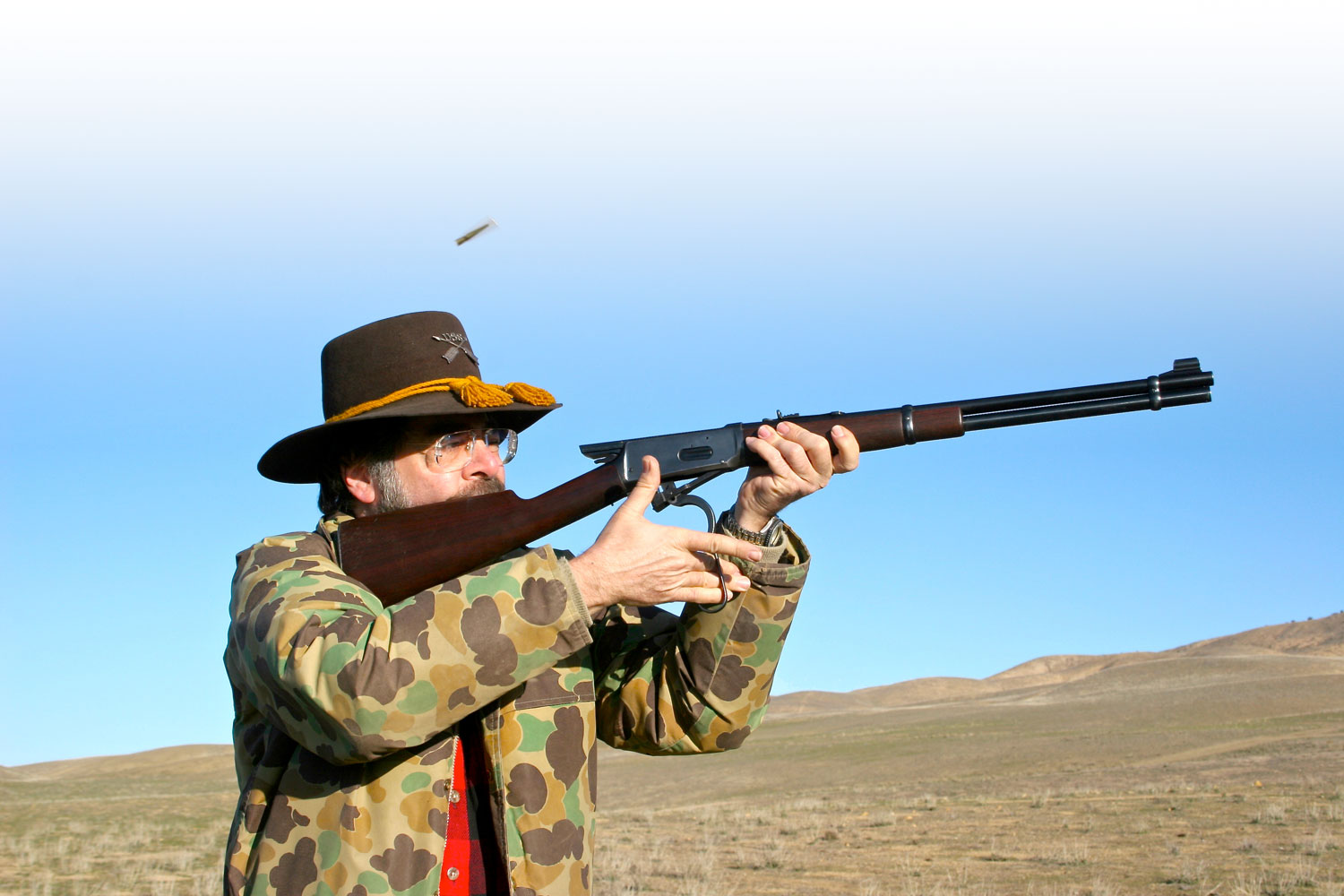
With its distinctive “drop down” action, the Winchester 94 is capable of providing fast follow-up shots.
Realizing the shortcomings of the Henry’s design, in 1866 the next rifle to come out of the New Haven Arms Company’s factory was—quite naturally—the Improved Henry Rifle (later renamed as the Model 1866), which featured frame-loading for cartridges and a wooden forend to protect the shooter’s supporting hand. In 1867, when the company was renamed the Winchester Repeating Arms Company, the Model ’66 became the first to be stamped “Winchester.” Unfortunately, it was still chambered for the same underpowered 44 Henry Flat. However, because it also used the same cartridge as the Smith & Wesson No.3 and the Colt 1871-72 Open Top revolvers, it proved extremely popular on the frontier, during a time when—with a little skill and a lot of luck—it was still possible to get within close, powder-burn range of many game animals.
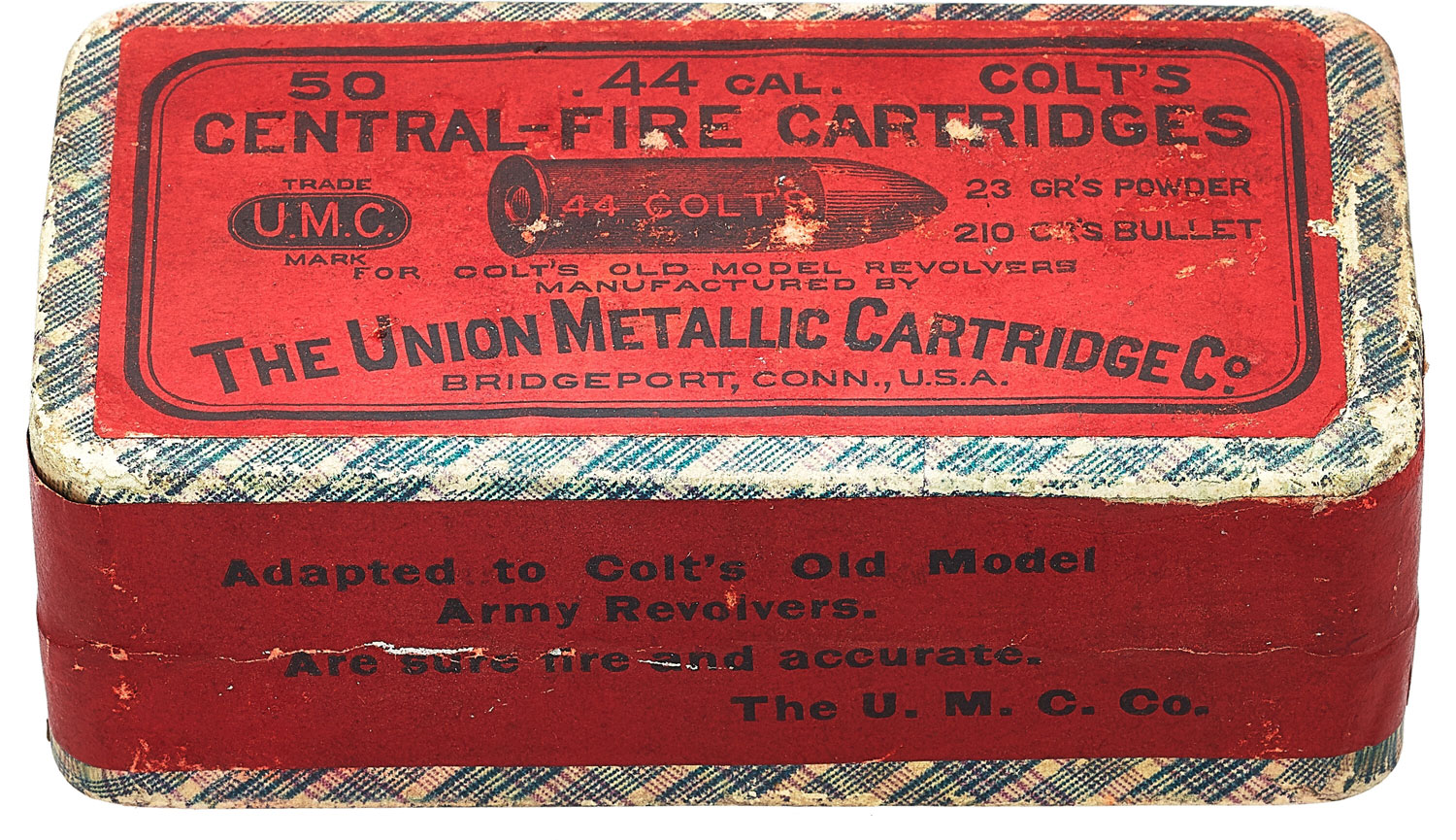
But it was the Winchester Model 1873, with its stronger iron (later steel) frame and newly designed 44 W.C.F. (Winchester Center Fire), a.k.a. 44-40 cartridge, that started to attract more hunters to the lever-action rifle, for here, at last, was a cartridge that could be reloaded. And in 1878, when Colt began chambering its popular Single Action Army for the same 44-40 cartridge, the success of both rifle and pistol soared, even though the 44-40, with its 200-grain bullet powered by 40 grains of blackpowder was, in reality, barely adequate for deer-sized game. Still, there were more firearms chambered for this slightly bottlenecked round than any other during the last quarter of the 19th century.
Appropriately enough, the Model ’73 was the first lever action I ever owned, having acquired a reblued, cut-down 44-40 octagon barreled rifle in some obviously convoluted trade while struggling to get through college. I remember dispatching a few jackrabbits in the desert outside of Phoenix with that rifle, and puncturing way more tin cans, but my main objective was to acquire enough silver dollars (they were plentiful back then) to decorate one side of the stock with them. I honestly can’t recall what happened to that rifle; I’m sure I traded it for something of more value. But I do remember I was pleasantly surprised with the ’73’s mild recoil. Obviously, that feeling was no doubt shared by hunters in the past.
Back then, realizing the need for a more powerful lever action capable of taking down larger game such as brown bear and moose, Winchester’s next move was to beef up the Model 73. What the company came up with was the Model 1876 or The Centennial Rifle, inasmuch as it was unveiled at the Philadelphia Centennial Exhibition of 1876, which celebrated America’s first 100 years as a nation. Basically, the Winchester ’76 was a Winchester ’73 on steroids, with a more muscular receiver, a longer and thicker barrel and proportionately heftier stocks. And because of its larger action, the Model ’76 was able to handle a harder-hitting proprietary 45-75 cartridge, along with later chamberings of 50-95 Express, a popular 45-60, and an even flatter shooting 40-60.
Of these, the 45-75, with a half round/half octagon barrel and festooned with John Ulrich engraving, was the favored rifle of a young, 22-year-old Teddy Roosevelt on his 1884 hunting trip in the Dakota Badlands—so much so that he ended up ordering two more nearly identical rifles in 40-60 caliber “for deer and antelope” during his forays into Dakota Territory. Of the 45-75 Winchester ’76, Roosevelt wrote in his 1885 book, Hunting Trips of a Ranchman, “The Winchester, stocked and sighted to suit myself, is by all odds the best weapon I ever had, and I now use it almost exclusively, having killed every kind of game with it, from a grizzly bear to a big-horn….”
In spite of such praise, however, the Model ’76 was still encumbered by its predecessor’s basic toggle link action, although I have used my Model ’76 in 45-60 to effectively make one shot kills on game as tough-skinned as wild boar. However, the rifle’s 10-plus pounds of weight when fully loaded was definitely a deterrent for my taking it on long treks. But of even greater disappointment for a number of hunters back in the 19th century was the fact that its receiver was too short to handle the most in-demand big game cartridge of the day, the 45-70 Government.
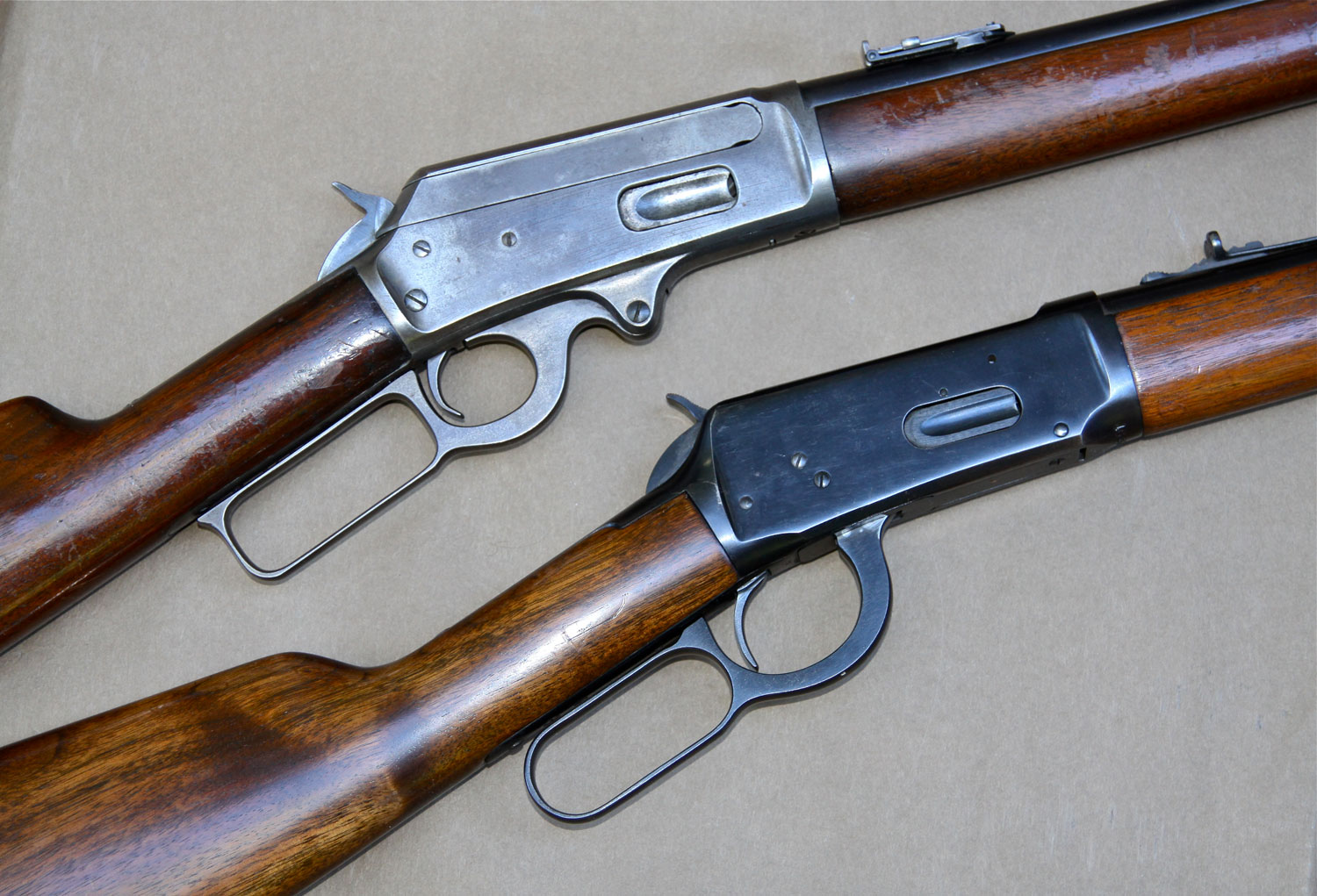
Hacker still hunts with his Marlin 1893 rifle (top) and his pre-’64 Winchester 94 carbines; both have distinctively different—but reliable—actions. However, a vintage lever action should always be checked by a competent gunsmith before taking it afield.
That’s when Marlin—which would go on to become Winchester’s biggest competitor – stepped in with its Model 1881, the first—but certainly not the last—lever gun to be produced by John Mahlon Marlin’s New Haven, Connecticut, company. Previously, Marlin had been manufacturing rimfire pocket pistols and, from 1871 on, Ballard single-shot rifles, whose noted accuracy brought them into the hunter’s camp. But now many a Winchester was passed over in lieu of the new top-ejecting Marlin Repeating Rifle, as it was initially called (it was not listed as the Model 1881 until the appearance of Marlin’s second lever action in 1888), which was not only able to chamber 45-70 ammunition, but the flatter-shooting (albeit less powerful) 40-60 Marlin and later, 32-40, 38-55 and 45-85—all of which were creditable big game cartridges. Noted for its smooth action and commendable accuracy thanks to barrels made on Ballard machinery, the Model 1881’s popularity was thwarted by its hefty $32 price tag (far more than any Winchester), an even heftier 10 pounds of weight, and an occasional propensity to jam. Still, for a while it became a favorite hunting rifle of Buffalo Bill Cody, but even that endorsement was pushed aside by the emergence of the Winchester Model 1886, the first of what was to become a long line of iconic Winchester lever actions designed by John Moses Browning.
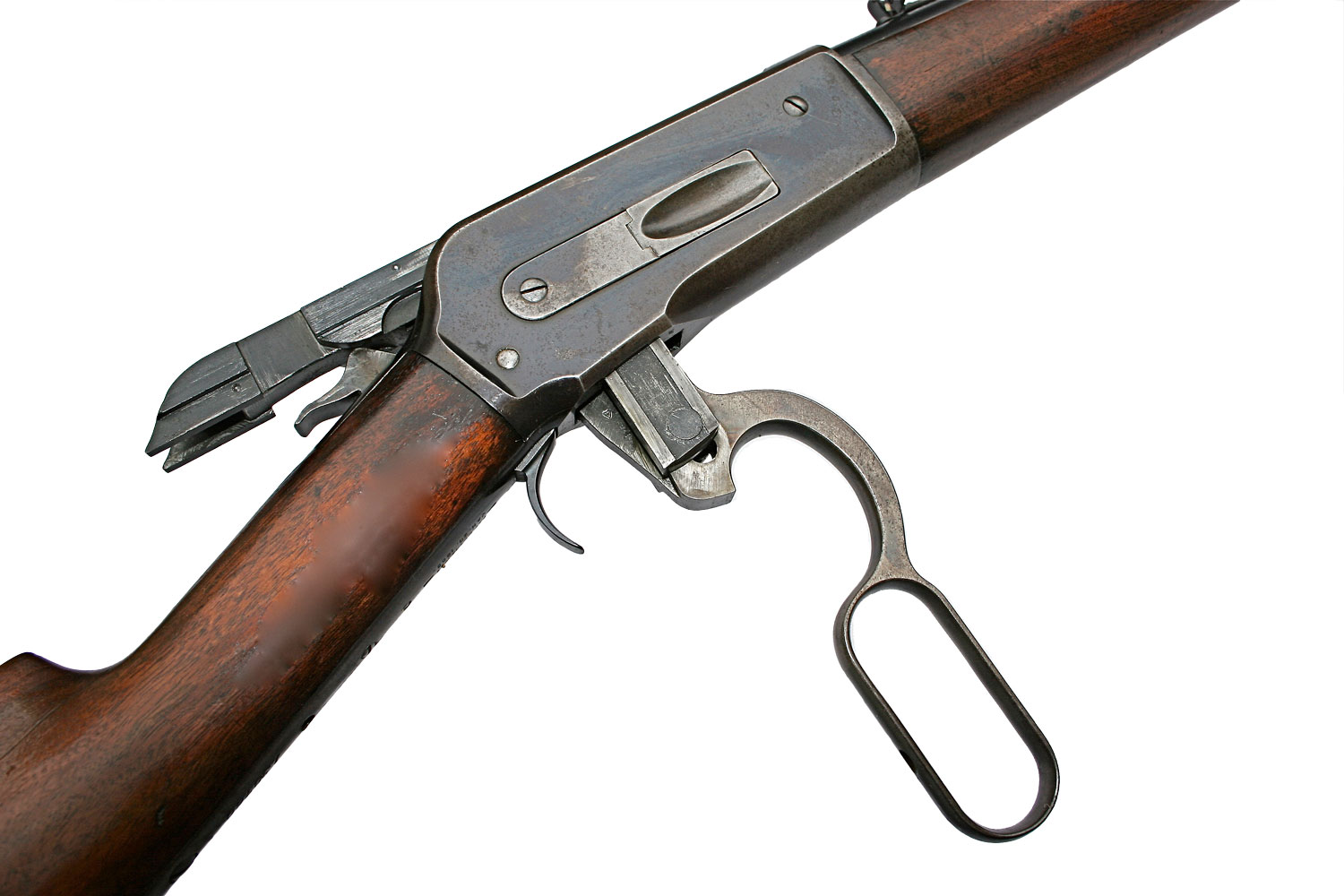
The Winchester 1886 was a big, beefy lever action with an action as smooth as warm butter yet as strong as a Sherman tank. It was chambered for a multitude of big game cartridges, including the 45-70 Government and the 50-110 Winchester.
For me, the Winchester ’86 is the smoothest-shooting lever action of them all (with the possible exception of the Winchester 1892, which is basically a scaled-down ’86). Gone was the toggle link action of previous Winchesters and in its place were twin vertical locking bolts that slid up through the muscular receiver when the lever was returned home to firmly anchor the bolt closed. With an action as smooth as warm butter yet strong as a Sherman tank, it was chambered for a multitude of big game cartridges, including not only the 45-70, but also other hunters’ favorites, ranging from the 40-65 WCF all the way up to the bone crushing 50-110 Winchester. Small wonder it quickly became Theodore Roosevelt’s favorite big game rifle, along with countless other outdoorsmen who considered the Model ’86 the ultimate big game lever action of its day. For me, in many ways, it still it.
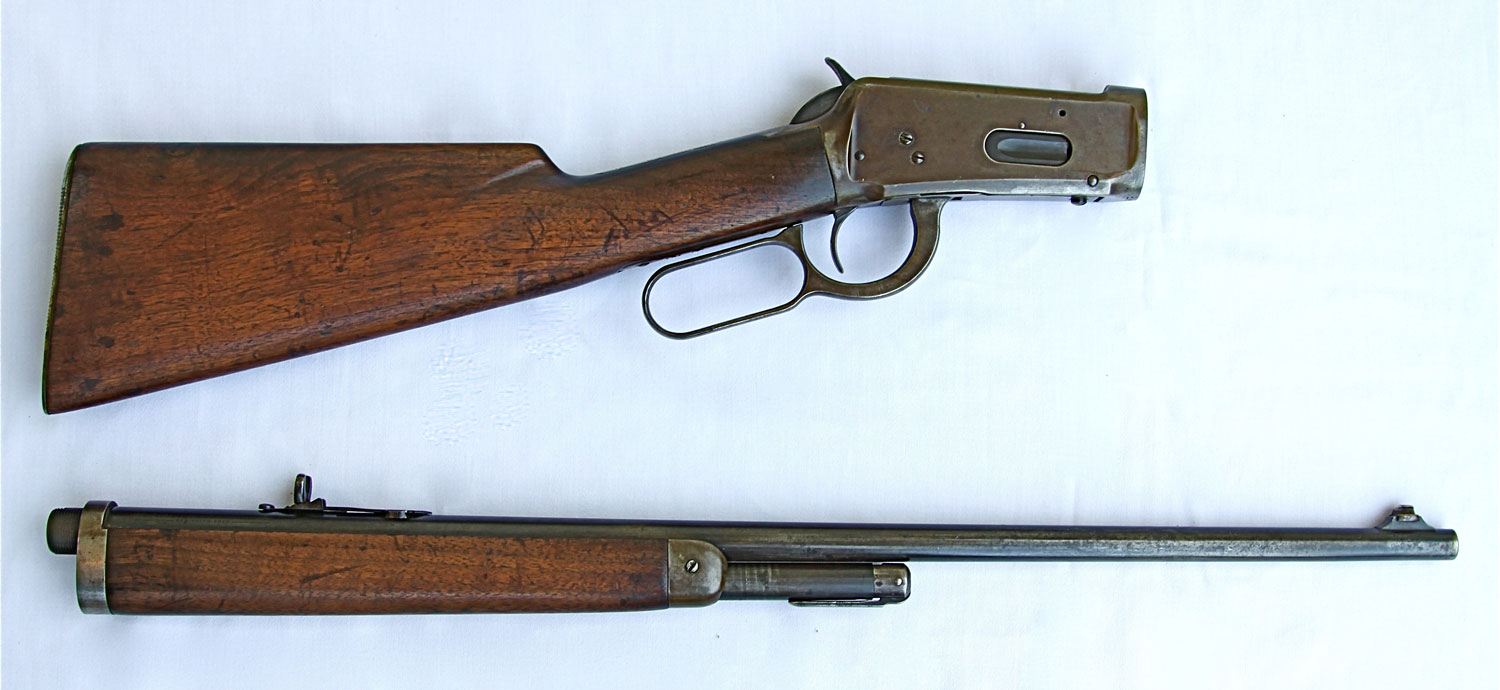
One advantages of vintage lever actions rarely available on today’s hunting rifles was an optional take-down feature, as seen on this Winchester Model 55, which made it more
convenient to transport.
Needless to say, I own more than one. I bought my first Model ’86, an octagon-barreled rifle in 38-56 caliber that was made in 1890 and with only 20-percent finish remaining, at the old Great Western Gun Show in Los Angeles, back in the 1980s. Because it was chambered for an obsolete caliber, nobody wanted that rifle, so I was able to buy it for $60. I then had the rifle rechambered to 45-70 by none other than P.O. Ackley, one of the greatest gunsmiths, barrel makers and wildcat cartridge impresarios of the day. Using Federal 300-grain jacketed hollow points, that rifle consistently printed 1 1/2-inch groups at 100 yards, although after numerous deer hunts, I finally switched to Remington’s 405-grain lead bullets, and more recently, Cowboy Loads from Black Hills, as the copper-jacketed ammo had begun to wear the rifling of the barrel’s soft steel.
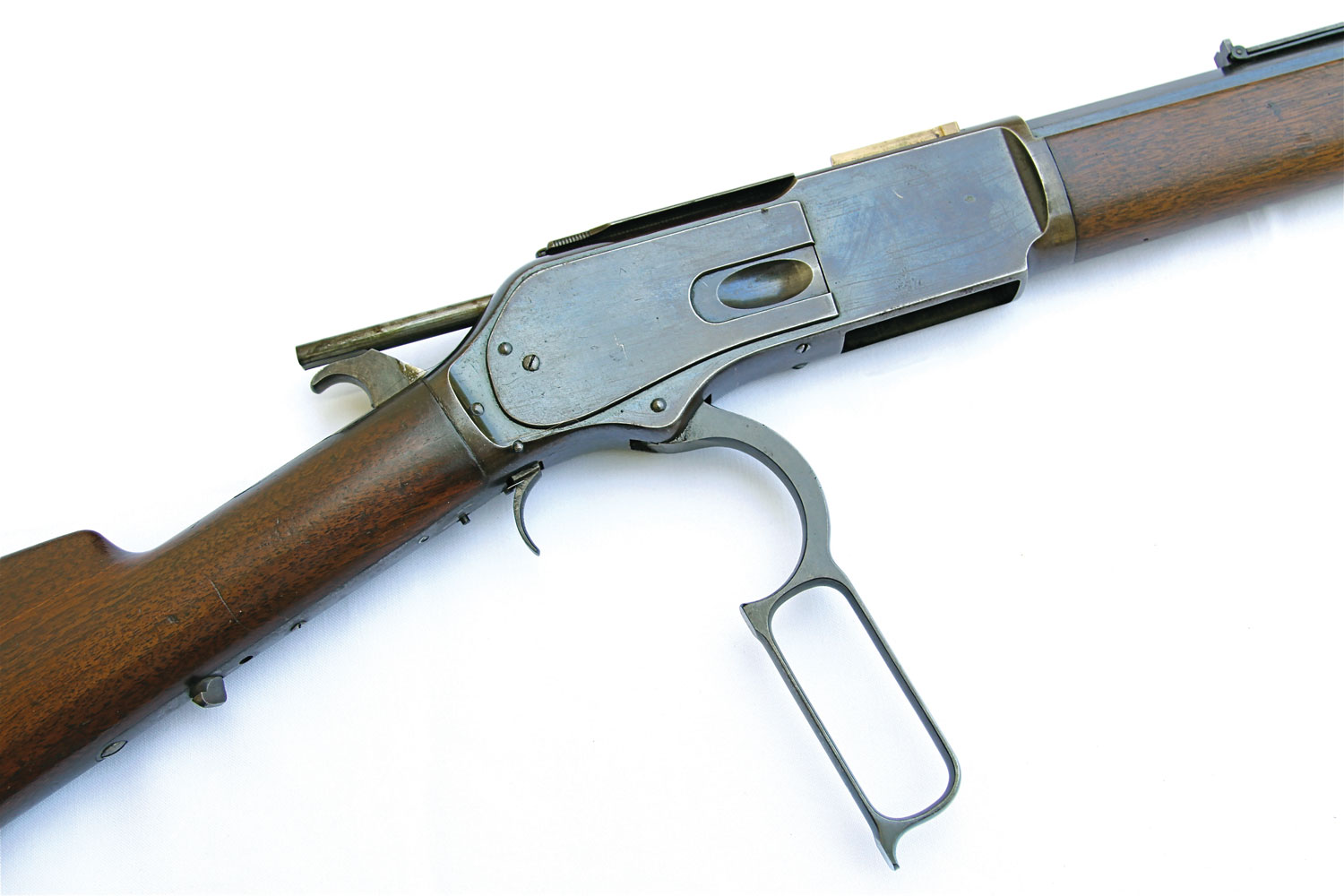
The Model ’76 still used the toggle link action of the smaller Winchester ’73 and in spite of its massive size, the receiver was still too short to handle the popular 45-70 cartridge.
In fact, when blackpowder cartridges evolved into smokeless powder, the only tweak required for the big ’86 was to upgrade its barrels to nickel steel. The action was that strong. And in 1935 when The Great Depression resulted in the discontinuance of the Winchester 1886, its popularity prompted it to reemerge one year later as the Model 71. Chambered for only one cartridge, the .348 Winchester, the Model 71 was only available with a 3/4 magazine but could be had in a 24-inch barreled deluxe checkered stock version or as a shorter 20-inch barreled uncheckered carbine. Three styles of rear sights were offered at various times: a bolt-mounted peep, a receiver-mounted peep and an adjustable open sight. Quoting from Winchester’s introductory 1936 advertising copy:
“It is a rifle suitable for all North American big game from Alaskan moose and Kodiak bears to Florida deer and panthers. With the heavier 250-gr. cartridge, right, too, for South American jaguars, African buffalo and lions, Asiatic tigers….”
It remained in the line until 1958, and while I have never taken any African buffalo, lions or Asiatic tigers with the Winchester 71, I have taken deer, wild boar and elk with each of the three Model 71s (one for each of the three sight configurations) that I own. None required more than one shot, even though the slick action was more than ready for a follow-up. Small wonder Winchester—under license to Japanese firearms manufacturer Miroku—reissued both the Models ’86 and the 71 in modern times.
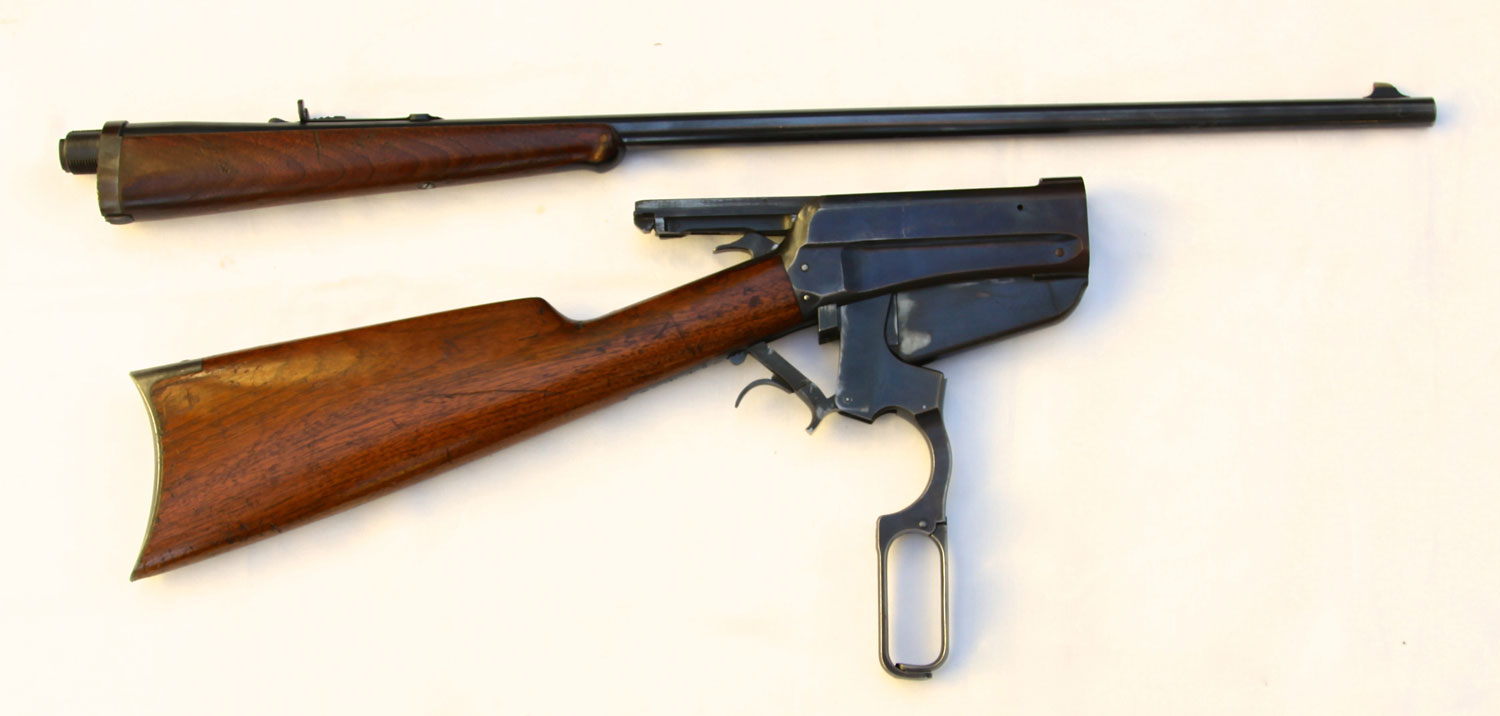
The author’s take down version of the Winchester 95 was made in 1913 and is chambered for 30-40 Krag. It is an excellent deer rifle, hampered only by the lack of a ready supply of factory ammunition.
Meanwhile, back in the 19th century, Marlin’s Model 1881 was losing sales to Winchester’s Model 1886 and perhaps in retaliation—or just old-fashioned competition—Marlin first brought out its smaller framed and very scarce Model 1888, of which only 4,800 were made, before introducing its Model 1889 one year later. Basically the same rifle, this was Marlin’s first side-ejecting lever action and—with a definite snub to the top-ejecting Winchesters, was dubbed “the New Safety Rifle.” Both guns were chambered for the same “holy trinity of calibers,” as Winchester’s Model 1873: 32-20, 38-40 and 44-40, all of which leads one to suspect that small game hunting was increasing in popularity. This is born out by Winchester soon responding with its Model 1892, built on a scaled-down ’86 action and chambered for the 1873’s same calibers, which some folks stretched to include deer hunting, although the 44-40 is marginal at best, unless carefully handloaded and kept away from Single Action Armies and their ilk. That is why, after Winchester and the Union Metallic Cartridge Company brought out the “High Velocity 44-40” in 1903 to indeed make the Model 92 venison-worthy, that high velocity variation was subsequently cancelled, as too many hunters were blowing the bolts out of their older Model ’73s (and sometimes various parts of their appendages as well), as that earlier Winchester wasn’t as strong as the Model 92.
About this same time the ongoing popularity of deer hunting along with other medium-sized game prompted Marlin to come out with its Model 1893 (which eventually became the Model 93, then the Model 36 and ultimately, today’s 336) initially in 32-40 and 38-55 blackpowder cartridges, and later in smokeless 30-30 Winchester, 32 Winchester Special (which Marlin called 32 High Power Special) and the proprietary 25-36 Marlin. For many years I used my 1893 Marlin in 38-55 on Texas whitetail hunts, where it proved extremely accurate with open sights as long I kept my shots within 100 yards—which admittedly, is not always easy to do on Texas whitetail hunts.

Teddy Roosevelt liked to hunt with his ornate Winchester rifles as evidenced by his factory engraved Winchester 92 saddle ring carbine, serial #53614, in 44-40 caliber. Fully embellished with Winchester Style No. 9 engraving by John Ulrich and Style H fancy grade checkered walnut stock and forend. Courtesy Frazier History Museum; Louisville, KY.
The lure of big game hunting also led to the Marlin 1895, a hefty lever action chambered in 38-56, 40-65, 40-82 and 45-70 as well as the 45-90 and 33 Winchester Center Fire (WCF). However, as of this writing, this is the only big bore Marlin lever action currently in production under Ruger’s new ownership of this 152-year-old company—the new stainless steel 1895 SBL with updated features including a laminated stock, Picatinny rail and large loop lever. I have it on good authority that the Models 1894 (which was basically an improved Model 1889) and 336 will soon be back as well. But without a doubt, it was the Marlin Models of 1893 and 1895, with their more powerful chamberings, stronger designs, and side ejection that ultimately spelled the end of the Model 1881 in 1891.
Of course, Marlin wasn’t the first to introduce sporting rifles chambered for smokeless powder. That honor has to go to the Winchester Model 1894—the first rifle to be chambered for the first two smokeless cartridges, the 25-35 and the 30 WCF, which came to be known as the 30-30 Winchester. Ironically however, due to metallurgy problems with the Model 94’s nickel steel barrels, production was delayed a year. Thus, the first smokeless powder repeater was initially only available for two older blackpowder rounds, the 32-40 and the 38-55. It wasn’t until 1895 that the Model 94 finally came out in the much touted 25-35 and 30 WCF chamberings.
I was first made aware of this classic deer gun as a black and white line drawing in the late Harold F. Williamson book, Winchester—The Gun That Won the West. As a kid, I remember pouring over that book and studying every line of that illustration of the Winchester Model 1894 carbine—its square-shouldered receiver, the noticeably large trigger guard (especially when compared with those of the earlier Winchester saddle carbines) and the graceful complementing tapers of the barrel, magazine tube and “long wood” walnut forend. Of course, back then I was too young to purchase, let alone afford, a Model 94 carbine.
But one day that moment came. It was at the old Pinney & Robinson’s Sporting Goods store at the Park Central Shopping Center in Phoenix, Arizona. I was browsing the gun racks, as I often did, and there it was, a slightly used flat-band Model 94 carbine in the coveted 30-30 caliber, which everyone knew was the deer cartridge. If you wanted to go after bear, the old-timers told you to get a Model 94 in 32 Winchester Special. But if it was venison for the table, then only a 30-30 would do.
Of course, the reality is that both cartridges are practically identical, ballistically speaking, and the only reason the 32 Special was developed in 1895—the same year the 30-30 was introduced—was that unlike the faster 1:12-inch twist rifling of the 30 WCF, the slower 1:16-inch twist of the 32 Special was more suited to stabilizing the bullet when reloading that cartridge with blackpowder, obviously to appeal to hunters back then who didn’t trust a cartridge whose smoke they couldn’t see.
Needless to say, I was mesmerized by that 94 flat band (a unique postwar feature of Model 94 carbines produced from April 1946 through December 1948) in Pinney & Robinson’s used gun rack. To make it even more tantalizing, the carbine came with a saddle scabbard stamped “Marfa, Texas.” The rancher who had previously owned that Model 94 had brought it in to trade for a “modern” bolt-action rifle. I was glad he did.

In addition to having taken numerous deer with his 1893 Marlin rifle in 38-55 caliber, Hacker also hunts with the carbine version of this gun in 30-30 caliber. Although factory records for the Model 93 are incomplete, this particular carbine was made in the early 1920s.
I ended up trading a 22-caliber Springfield Model 87A semi-automatic rifle and $30 cash and, although I have acquired numerous Winchester 94 rifles, carbines and even a trapper since then, I still have that scabbard! As I recall, the asking price for gun and leather was $50. Later that year I took my first mule deer with that flat band, thus perpetuating the Model 94’s reputation of having taken more deer than any other rifle in America. To be sure, the Model 94 and the 30-30 cartridge were so indelibly intertwined, that, when I was growing up in Arizona, the gun was often simply referred to as a “thuty-thuty,” no matter what its caliber. In fact, for a long time I was under the impression that all pickup trucks came with a rifle rack and a Model 94 carbine in the cab’s rear window as standard equipment.
Because the 94, like all previous Winchester lever actions, had a tubular magazine where one cartridge butted up against the next, the bullets were by necessity round or blunt-nosed to avoid accidently piercing the primer during recoil and setting off of the succeeding round. But a combination of the growing use of spitzer bullets coupled with John Browning’s ingenuity led to the development of the fixed box magazine Winchester Model 1895. Chambered in 30-03 Government (forerunner to the 30-06 Springfield), 303 British, 30-40 Krag, 30-06 Springfield, 35 Winchester Center Fire, 38-72 WCF and 40-72 WCF, it was the .405 Winchester chambering that made the Model 95 the most powerful lever action of its day. Consequently, it became a favorite of many serious big game hunters, including novelist Zane Grey, and Teddy Roosevelt, who took two identical custom-configured Model 95s in 405 Winchester on his 1909 African safari—having been talked out of taking his beloved Winchester ’86 to the Dark Continent by the executives at Winchester, who were understandably eager to promote their newest lever action. They must have been convincing, for Roosevelt ordered two more Model 95s for his son Kermit (one in 405 Winchester and the other in 30-03), who accompanied him on his safari. Winchester couldn’t have hoped for better publicity, for as TR stated in his book, African Game Trails, “…the Winchester .405 is, at least for me personally, the ‘medicine gun’ for lions.” Not surprisingly, subsequent Winchester ads dubbed the Model 95 as Roosevelt’s ”Medicine Gun.”
Then came the revolutionary (literally) Savage Model 1895 and the more legendary Model 99, trend-setting hammerless lever actions that featured a unique five-shot rotary magazine specifically designed for spitzer bullets. Chamberings included 303 Savage, 30-30, 22 Hi-Power, 300 Savage, the less encountered 25-35, 32-40, and 38-55 and the classic 250-3000—the first American cartridge to reach the 3,000 feet per second mark. I’ve used my Savage 99EG in this caliber to effectively eradicate a coyote or two, but the scarcity of ammo has relegated it to the back corner of the gun safe recently. Sadly, the Model 99 in all its variations was discontinued in 1997, just two years shy of its 100th anniversary.
Nonetheless, all of these vintage lever actions, with the exception, of course, of the earliest rimfire models, are still with us in various hunting camps around the country (although any vintage lever action should always be checked by a competent gunsmith before taking it afield). Yes, they have range and caliber limitations, but they all have a legacy of history built into them and possess an aura of having “been there, done that.” And while many of them have achieved a collectable status and various degrees of rarity, they still are very much capable of “making meat,” and doing it in style.

